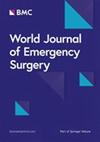Use of tranexamic acid in trauma surgical specialties: a narrative review
IF 5.8
1区 医学
Q1 EMERGENCY MEDICINE
引用次数: 0
Abstract
Tranexamic acid (TXA) is a well-known antifibrinolytic agent with increasing evidence supporting its use in trauma patients. This review evaluates the current available literature regarding TXA and its potential use to improve patient survival and reduce transfusion needs across multiple trauma surgical subspecialties and contexts. A literature review was conducted on the efficacy and safety of tranexamic acid in trauma surgical specialties using PubMed (MEDLINE) and Google Scholar from database inception to October 2024. Selected articles were written in the English language and encompassed reviews, experimental studies, and basic science articles. There is conflicting evidence on the mortality benefit of TXA, particularly in the prehospital setting. However, multiple large, high-quality studies have shown that TXA is an effective agent to reduce bleeding after trauma. Extensive evidence exists that TXA is a safe medication, with numerous studies demonstrating no increased risk of thromboembolic events after administration of TXA in trauma settings. Additionally, multiple cost-effectiveness studies conducted in several countries have found TXA to be a highly cost-effective intervention following trauma. TXA is a safe, effective, and cost-effective medication to reduce bleeding after trauma. Future research on TXA is needed to elucidate the potential benefit of TXA after traumatic brain and spine injury and the optimal dose and route of administration of TXA.氨甲环酸在创伤外科专科的应用:述评
氨甲环酸(TXA)是一种众所周知的抗纤溶药物,越来越多的证据支持其在创伤患者中的应用。本综述评估了目前有关TXA的文献,以及TXA在多个创伤外科亚专科和背景下提高患者生存率和减少输血需求的潜在用途。利用PubMed (MEDLINE)和谷歌Scholar数据库对氨甲环酸在创伤外科专业的疗效和安全性进行文献综述,时间自数据库建立至2024年10月。选定的文章用英语撰写,包括综述、实验研究和基础科学文章。有相互矛盾的证据表明,TXA的死亡率效益,特别是在院前设置。然而,多项大型、高质量的研究表明,TXA是一种减少创伤后出血的有效药物。大量证据表明,TXA是一种安全的药物,大量研究表明,在创伤环境中使用TXA后,血栓栓塞事件的风险不会增加。此外,在几个国家进行的多项成本效益研究发现,TXA是创伤后的一种极具成本效益的干预措施。TXA是一种安全、有效、经济有效的减少创伤后出血的药物。需要进一步的研究来阐明创伤性脑和脊柱损伤后TXA的潜在益处以及TXA的最佳剂量和给药途径。
本文章由计算机程序翻译,如有差异,请以英文原文为准。
求助全文
约1分钟内获得全文
求助全文
来源期刊

World Journal of Emergency Surgery
EMERGENCY MEDICINE-SURGERY
CiteScore
14.50
自引率
5.00%
发文量
60
审稿时长
10 weeks
期刊介绍:
The World Journal of Emergency Surgery is an open access, peer-reviewed journal covering all facets of clinical and basic research in traumatic and non-traumatic emergency surgery and related fields. Topics include emergency surgery, acute care surgery, trauma surgery, intensive care, trauma management, and resuscitation, among others.
 求助内容:
求助内容: 应助结果提醒方式:
应助结果提醒方式:


